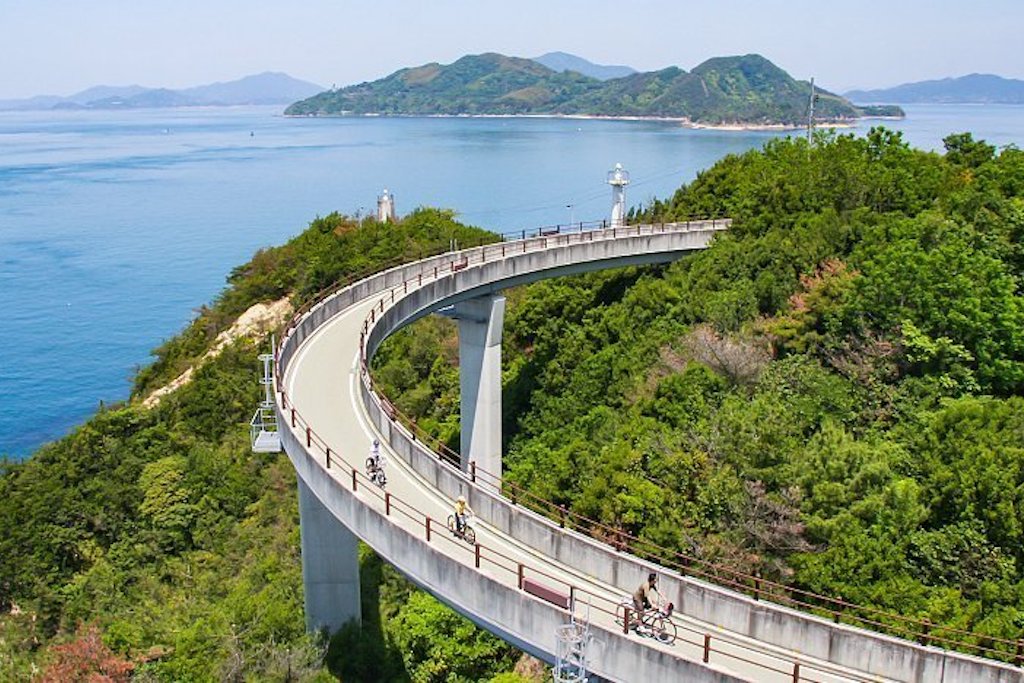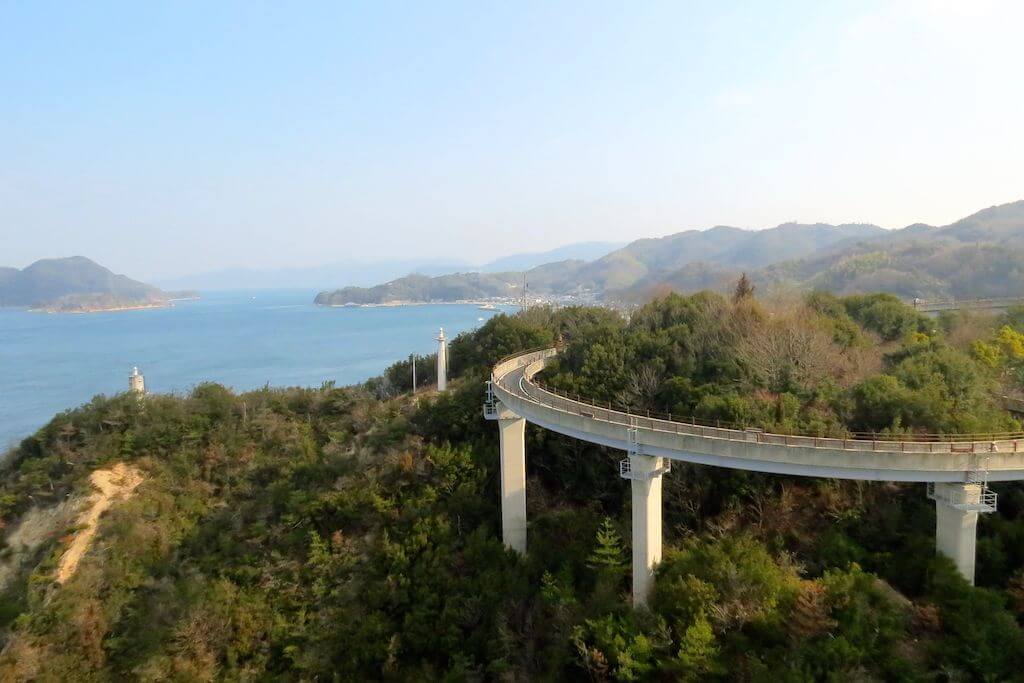Autumn Gear Guide
Find inspiration in our Gear Guide that will keep you out on your bike through wind or rain.
Download NowIf Japan has a paradise for cyclists, the Shimanami Kaidō is it. This 70-kilometre route connects the main island of Honshu with Shikoku, weaving across six small islands in the Seto Inland Sea via a series of grand bridges. It’s more than a ride—it’s a cultural journey, an architectural marvel, and a love letter to […]
If Japan has a paradise for cyclists, the Shimanami Kaidō is it. This 70-kilometre route connects the main island of Honshu with Shikoku, weaving across six small islands in the Seto Inland Sea via a series of grand bridges. It’s more than a ride—it’s a cultural journey, an architectural marvel, and a love letter to coastal Japan. Expect sea breezes, citrus groves, tranquil fishing villages, and plenty of pit stops for local ramen and lemon sorbet.
And best of all? It’s designed with cyclists in mind. In short, it is one of the best cycling routes in the world.
Welcome to Japan’s cycling playground—a route where coastal beauty, friendly locals, and an unusually thoughtful cycling infrastructure combine to create an unforgettable two-wheeled experience.
The Shimanami Kaidō offers a dedicated bike path along nearly the entire route, often completely separated from motor traffic. The road itself is marked by the now-iconic “Blue Line,” a bright stripe that helps cyclists stay on course and alerts them to key distances and landmarks. Spiral bridge ramps allow for easy, car-free ascents, while strategically placed rest stops keep you comfortable, hydrated, and informed.
From the moment you set off, the ride unfolds like a storybook: orange groves and sandy beaches give way to soaring steel bridges and sleepy towns where time seems to slow. On Ikuchi-jima, you might coast past citrus orchards, while on Ōmishima, you’ll find yourself climbing to one of Japan’s most historically significant shrines. Then there’s the Kurushima Kaikyō Bridge, the world’s longest series of suspension bridges—your grand finale before rolling into Imabari.
While the modern cycling path was officially launched in 1999, the islands that make up the Shimanami Kaidō corridor have long been pivotal in Japanese history. Ōmishima Island, for example, is home to Ōyamazumi Shrine, which dates back more than 1,000 years and once served as a spiritual hub for samurai and seafarers alike. During the Sengoku period, the area was home to the Murakami Kaizoku—powerful naval clans who ruled the Seto Inland Sea and acted as both pirates and protectors of the shipping routes.
Today, the sea still bustles with activity—but now it’s pleasure craft, cargo ships, and cyclists who claim the lanes.

The Shimanami Kaido, Japan
Most cyclists begin in Onomichi, a historic port town in Hiroshima Prefecture. Easily accessible via the JR Sanyō Main Line (about 90 minutes from Hiroshima), Onomichi offers a charming start point, with narrow alleys, hillside temples, and waterfront cafés. From here, a short ¥110 ferry ride takes you across to Mukaishima Island—skipping the busy Shin-Onomichi Bridge and easing you into the journey.
From there, it’s island-hopping bliss: Mukaishima ➡︎ Innoshima ➡︎ Ikuchi-jima ➡︎ Ōmishima ➡︎ Hakata-jima ➡︎ Ōshima ➡︎ and finally into Imabari on Shikoku.
The Shimanami Rental Cycle system makes the logistics easy. With 13 terminals, you can rent bikes at one end and drop them off at the other. Options include standard city bikes, road bikes, e-bikes, and even tandems. Rental prices start at around ¥2,000 per day, with an additional one-way return fee of ¥1,100 if you don’t return the bike to your starting point.
Pro tip: Book your bikes online in advance—especially during the busy spring and autumn seasons.
Need your luggage transported while you ride? Several companies offer same-day baggage delivery from Onomichi to Imabari (or vice versa), so you can ride light and check into your guesthouse with everything waiting for you.
The fittest riders can complete the 70 km route in a single day—roughly 6–8 hours with breaks. But most cyclists choose to ride it over two days, giving themselves time to enjoy the scenery, take in a few museums, and stay at one of the charming island guesthouses. Ikuchi-jima or Ōmishima are ideal overnight stops.
Spring (March–May) and Autumn (October–November) are ideal, offering mild weather, clear skies, and lush island views.
Summers can be hot and humid, and while winter is rideable, it brings cooler temps and shorter days.
Innoshima Bridge
The first major span, with a dedicated lower deck just for cyclists and pedestrians, offering stunning views of fishing villages and the shimmering sea.
Setoda Town on Ikuchi-jima
A popular lunch stop known for its lemon products (mikan juice is a must). Explore Hirayama Ikuo Museum of Art and enjoy beachfront cafés like Dolce for fresh citrus sorbet.
Tatara Bridge
One of the longest cable-stayed bridges in the world, with a gorgeous viewing plaza at the top. It’s also where you cross from Hiroshima into Ehime Prefecture.
Ōyamazumi Shrine on Ōmishima
This ancient shrine is dedicated to sea gods and warriors. Its treasure hall houses the largest collection of samurai armor and weapons in Japan.
Kurushima Kaikyō Bridge
Your final crossing and a true engineering marvel—almost 4 km long with dramatic views of passing ships and distant islands. It’s a victory lap before you roll into Imabari.

Shimanami Kaido
Each island has rest areas (“Cycle Oasis” stations), with water, toilets, tools, and vending machines. Many feature cafés or small shops with local delicacies.
Must-tries include:
Shimanami ramen – often featuring locally caught seafood.
Mikan juice – a regional citrus specialty.
Sea bream (tai) – try it grilled, in donburi, or even as sushi.
Island lemons – in cakes, pastries, or just fresh.
Many roadside stops even sell handmade souvenirs, citrus-infused bath salts, and artisanal crafts.
Though the Shimanami Kaidō was toll-free for cyclists until 2022, a small fee is now collected to maintain the infrastructure. Cyclists pay approximately ¥500 ($5 CAD) total for all bridges—usually through simple coin boxes or automated gates at each span. Bring change!
Because this is cycling at its most joyful.
There are longer rides. Harder climbs. Wilder adventures. But none so seamlessly blend infrastructure, scenery, and culture the way the Shimanami Kaidō does. Whether you’re a veteran bikepacker or a casual tourist with a day to spare, the route offers something rare: the freedom to travel, to connect, and to slow down long enough to take it all in.
So follow the Blue Line. Feel the sea breeze. And let the Shimanami Kaidō show you a different side of Japan—one pedal stroke at a time.
Find inspiration in our Gear Guide that will keep you out on your bike through wind or rain.
Download Now
Leave a comment